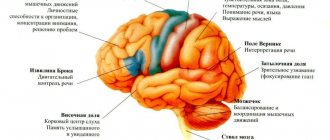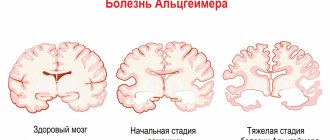Doctors Cost
Price list Doctors clinic
The feeling of numbness in the limbs is called paresthesia in medicine (from the Greek words “πᾰρά” - “outside, around, past” and “aisthesis” - “sensation”). This is the loss of normal tissue sensitivity due to impaired transmission of nerve impulses. It seems to a person that he is being touched through a layer of cotton wool.
Occurs at any age, often accompanied by tingling and goosebumps. It may be a physiological condition associated with prolonged compression of a nerve or blood vessels while in an uncomfortable position. When changing position, sensitivity is quickly restored. If the sensation is repeated, is not associated with an uncomfortable position, and lasts a long time, it requires diagnosis, as it may be a symptom of a dangerous disease.
Reasons for development
Various factors lead to impaired sensitivity, which can be divided into several large groups.
Table 1. Numbness of the extremities of the arms and legs: causes
| Cause | Examples of diseases, conditions |
| Squeezing blood vessels and nerve endings. | Intervertebral hernia, osteochondrosis, spondylosis, neoplasms. |
| Narrowing, blockage, deformation of veins. | Thrombophlebitis, varicose veins. |
| Cardiovascular diseases. | Cardiac ischemia. |
| Pathology of the nervous system. | Polyneuropathy, neuritis, radiculoneuritis, stroke. |
| Damage to blood vessels and nerves. | Injuries, postoperative complications. |
All paresthesias are fundamentally divided into two types.
- Transient. Caused by temporary compression of the neurovascular bundle – ischemia.
- Permanent. Occurs when there is anatomical damage to blood vessels or nerves.
If a person periodically experiences transient numbness, you should consult a neurologist for a thorough examination. This will help prevent life-threatening diseases: stroke, heart attack.
If an unpleasant sensation occurs and does not go away, you should also consult a doctor. Such problems do not disappear on their own. Without treatment, they can lead to disability.
Types of Numbness
Depending on the disease that provoked the syndrome, numbness can affect different parts of the body:
- If the cause is a pathology of the brain, the loss of sensitivity will affect the limbs on the opposite side. So, if the right hemisphere is damaged, the left leg or arm will suffer.
- With diseases of the spinal cord, numbness occurs in the area located below.
- Polyneuropathy provokes the “gloves and socks” syndrome.
- If the culprit is a peripheral nerve, the person will feel a loss of sensitivity in a finger - for example, the little toe on the foot, or the big toe - in the area of innervation.
Constant numbness in the extremities of the body
Carpal tunnel syndrome
The nerve fiber, located in a tight space limited by muscles and bones, is compressed by swollen tissues. Carpal tunnel syndrome is a common problem for modern people in certain professions: programmers, guitarists, artists, drummers - everyone whose work involves prolonged, monotonous stress on the hands. It manifests itself as paresthesia of the hand, pain, burning, sensation of electric shock, weakness, and inability to make some movements.
Radiculopathy
Compression of a nerve root by an intervertebral hernia. Numbness of an arm or leg depends on the level of compression and is accompanied by pain, muscle weakness, and impaired reflexes. At first it manifests itself as mild numbness of the extremities, gradually the symptoms increase. The pain decreases when lying down, but increases when the person stands, coughs or sneezes.
Metabolic polyneuropathy
It is characterized by a symmetrical lesion that develops due to a disturbance in metabolic processes in nerve fibers. It can be caused by diabetes mellitus, alcoholism, chronic renal failure, deficiency of vitamin B1, B12. Manifested by paresthesia, loss of sensation in the lower extremities, weakness, paresis.
Multiple sclerosis
Associated with the destruction of the myelin sheath (demyelination) of nerve fibers, which disrupts the conduction of nerve impulses. First, a transient sensation of numbness in the arms or legs appears, crawling along the fingertips, then the symptoms become more pronounced and permanent.
Polymyalgia rheumatica
Develops in people over 50 years of age. Accompanied by severe pain in symmetrical muscles, aggravated by movement, persisting at night. Most patients complain of muscle stiffness, numbness of the limbs in the morning and after prolonged immobility.
Factors of occupational hazard
Paresthesia is often caused by vibration and ultrasound. They damage peripheral nerves, cause loss of tactile sensitivity, numbness of the fingers, and intolerance to cold.
Why does hand numbness occur?
When a patient says that his upper limbs are numb, he may mean:
- a tingling feeling that causes discomfort;
- sensation of “goosebumps” under the skin;
- decreased sensitivity of the skin.
Numbness of the hands does not always indicate pathology. It may be the result of wearing too tight clothes and jewelry that compress blood vessels and nerves.
The most common causes of numbness in the hands:
- Uncomfortable body position, monotonous mechanical work, disrupting blood flow. After changing the position of the limb, the unpleasant sensations disappear.
- Carpal tunnel syndrome (usually affects the working hand due to prolonged monotonous work).
- Atherosclerosis. Accompanied by tingling and numbness of the hands, in the future a decrease in their muscle strength is likely.
- Osteochondrosis of the cervical spine (numbness, usually symmetrical, may intensify after physical activity).
- Diabetic neuropathy (usually both hands go numb).
- Intervertebral hernia in the cervical region (numbness is associated with compression of the spinal nerve roots).
- Ischemic stroke of the brain (threatens numbness and paralysis of the arm).
- Multiple sclerosis (if part of the postcentral gyrus of the brain is affected, the limbs may go numb).
- Thoracic outlet syndrome (compression of nerve trunks and blood vessels in the area of the upper chest opening).
- Brachial plexitis (numbness of the arm occurs due to inflammation of the brachial plexus).
- Damage to peripheral nerves due to alcoholism (alcoholic polyneuropathy).
- Brain tumor (the formation can compress the motor and sensory neurons responsible for the innervation of the upper extremities).
- Raynaud's disease (a disorder of the innervation of small arterioles, more common in women, manifested by numbness and pain in the extremities).
- Rheumatoid arthritis (inflammation and deformation of joints leads to compression of nerve fibers) and others.
Main services of Dr. Zavalishin’s clinic:
- consultation with a neurosurgeon
- treatment of spinal hernia
- brain surgery
- spine surgery
Diagnostics
Clinical symptoms are of great importance for making a diagnosis. Therefore, the doctor carefully asks the patient about when the disease began, how it manifests itself, and what helps.
Table 2. Differential diagnosis of numbness and tingling in the extremities. Possible reasons
| Affected limbs | Localization, features of numbness | Presumable disease |
| Upper | Sudden lesion of one arm. | Intervertebral disc herniation, spondylosis, osteochondrosis, plexitis, tunnel syndrome |
| Combined with impaired active movements. | Polyneuropathy, plexitis, tunnel syndrome. | |
| Symmetry. | Intoxication, infection. | |
| Blueness of fingers. | Raynaud's disease. | |
| Affects all fingers except the little finger | Carpal tunnel syndrome. | |
| Paresthesia of the little finger | Ulnar nerve neuritis, ischemic heart disease | |
| Lower | The pathological process affects the legs and lower back. | Osteochondrosis, lumbar hernia, atherosclerosis, pinched sciatic nerve, cauda equina syndrome. |
| Combined with impaired active movements. | Arthritis, multiple sclerosis, carpal tunnel syndrome, polyneuropathy, stroke. | |
| Damage to the lower leg and foot in combination with pain and muscle tension. | Thrombophlebitis, neuropathy, varicose veins. | |
| Paresthesia of the toes. | Arthritis of the thumb, radiculoneuritis, neoplasm, polyneuropathy. | |
| Top and bottom | Numbness of the left or right limbs | There may be several reasons: stroke, brain tumor, multiple sclerosis, transient ischemic attack. |
Preventing numbness in the hands
In order to prevent discomfort in the upper extremities, it is recommended:
- exercise regularly (discuss the type and nature of exercise with your doctor in advance);
- maintain the health of blood vessels, joints and the body as a whole (give up bad habits, eat rationally);
- dress according to the season, keep your hands warm;
- take breaks every 40 minutes if your profession involves working on a PC or performing monotonous hand movements.
Treatment
Table 3. Numbness of the extremities: causes and symptoms, treatment
| Cause | Symptoms, examples of pathologies | Treatment |
| Circulatory disorders | Ischemia, arterial hypertension, thromboembolism. | Treatment of the underlying disease. |
| Orthopedic problems | Disc herniation, osteochondrosis. | Conservative or surgical therapy to eliminate compression of the nerve roots. |
| Nerve compression | Tunnel syndrome, polyneuropathy. | Elimination of tissue edema, restoration of metabolic processes. |
Diagnosis of the causes of hand numbness. How to identify?
At the appointment, the doctor examines and palpates the patient’s limb and asks the following questions:
- Where exactly is the numbness felt?
- When did the unpleasant tingling sensation and decreased sensitivity first appear?
- How long does numbness in a limb bother you?
- What actions and movements aggravate symptoms?
- Are there any other complaints, such as burning, itching, tingling, pain?
- How do your arms, hands, and fingers feel—cold or warm?
The main task of the doctor is to determine the causes of hand numbness. It is necessary to exclude systematic mechanical compression of blood vessels, as well as to determine household and industrial factors that could cause disturbances.
Numbness may be a harmless symptom, but it may also hide serious problems - myocardial ischemia, stroke, spinal problems, diabetes mellitus, amyotrophic lateral sclerosis, etc. In this case, the doctor issues a referral to doctors of relevant specializations (cardiologist, endocrinologist, neuropathologist, etc.).
The main emphasis in identifying the causes of numbness is on detecting signs of osteochondrosis. For this, the patient is referred for magnetic resonance imaging, radiography, computed tomography, and electromyography. The purpose of imaging studies for arm numbness is to determine the height of the intervertebral disc, detect osteophytes, and clarify the presence of protrusion or intervertebral herniation.
What is intercostal neuralgia?
Neuralgia of the intercostal nerves is pain of a different nature that occurs due to various etiological factors. It is more often observed in adult men and women over 30-35 years of age. Symptoms of neuralgia may appear suddenly on one or both sides of the chest, along one or more intercostal nerves. The disease has an ICD code - M.79.2.
To understand what intercostal neuralgia is, you should understand the anatomical features of the thoracic nerves. There are 12 pairs in total. Each intercostal nerve contains motor, sensory and sympathetic fibers. It originates from the anterior roots of the spinal cord of the thoracic spine, passes along the lower edge of each rib, reaching the sternum. The parietal pleura covers the nerve fibers on top.
Thoracic nerves transmit impulses to the skin, the musculo-ligamentous apparatus of the chest and the anterior wall of the abdomen, partly the pleura and peritoneum, and the mammary glands. Sensitive fibers of neighboring nerve trunks actively interact with each other, creating cross innervation.
Manifestations of tingling, burning, numbness sensations
Along with these sensations, as a rule, other symptoms associated with a disorder of higher nervous activity may appear, such as decreased mood, sleep disturbance, causeless anxiety, internal trembling, as well as the following:
Often accompanying symptoms of numbness, burning, tingling
- Heart pain, palpitations, chest pain, chest pain.
- Psychosomatic disorders.
- Muscle pain. Muscle pain (“twists”).
- Lower back pain, heaviness in the lower back or back.
- Headaches of various types and intensity.
- Heaviness in the body. Heaviness in the limbs.
- Feelings of heat or chills. Attacks or “hot flashes” of heat, chills.
- Feeling of a lump in the throat. Difficulty swallowing, choking.
- Nausea, stomach pain, gastrointestinal disorders.
- Feeling of weakness, emptiness, fatigue.
- Dizziness. Impotence.
Causes of feelings of numbness, burning, tingling
Feelings of numbness, burning, tingling in various parts of the body, which can be due to various reasons.
For example:
- if a person has been in the same position for a long time, any part of the body may become numb,
- the situation can occur after long periods of heavy, tiring physical activity,
- if there is a lack of any microelements,
- may be an indicator of various vascular diseases,
- numbness, burning, tingling in various parts of the body can be associated with serious diseases caused by organic lesions of the central nervous system (for example, polyneuropathy is a fairly common disease in severe forms of alcohol addiction); - the most common sensations of numbness, burning, tingling manifests itself in various borderline mental states and are included in such syndromes as: neuroses, anxiety disorders, depression, etc.
Possible complications and consequences
Any neuralgia, in particular intercostal neuralgia, that does not respond to treatment, may be a sign of a serious illness. Most of the complications that arise with thoracalgia are precisely a manifestation of the underlying pathology, which worsens against the background of constant pain.
Chest neuralgia itself, with a long-term severe course, can provoke the development of a hypertensive crisis or an attack of angina (less often, myocardial infarction). Severe, constant pain affects a person’s physical and mental state in different ways. Often severe symptoms of intercostal neuralgia on the left or right significantly complicate the patient’s life. He sleeps poorly, is nervous, cannot move normally and do his usual work.
Pain in the intercostal spaces does not allow the patient to perform full breathing movements, which leads to a decrease in oxygen supply to the body and the development of hypoxia. Sometimes neuralgia is accompanied by such debilitating pain that it contributes to emotional exhaustion, and this is a serious complication, since this condition causes depression.
Neuralgia during pregnancy
If intercostal neuralgia appears in a pregnant woman, how to diagnose it and how to treat it is decided by a neurologist together with a gynecologist. Therapy is selected taking into account possible negative effects on the fetus. Self-medication in this situation is considered unacceptable, as this can have a negative impact on the health of the expectant mother and child.
To prevent chest neuralgia from appearing during pregnancy, it is advisable to follow preventive measures. If a woman has previously had attacks of thoracalgia, then at the stage of preconception preparation she should visit a neurologist and osteopath. The doctor will conduct a diagnosis, and then the neurologist will give a number of recommendations on how to treat intercostal neuralgia. An osteopath will identify possible causes of neuralgia and conduct a treatment session aimed at eliminating them.
Treatment of hand numbness in specialized hospitals
Department of Neurosurgery, City Clinical Hospital named after. A.K. Yeramishantseva sees patients with complaints of numbness in their hands. Here, progressive methods of conservative and surgical treatment of diseases manifested by such symptoms are used. Advanced technical equipment and extensive professional experience of the medical staff guarantee good treatment results. Telephone.
Neurosurgeon Evgeniy Evgenievich Zavalishin treats diseases that cause numbness in the hands. Sign up for a consultation by calling 8 (499) 940-04-30.
Goosebumps mainly on the left side of the body from the legs to the head
Elena
April 11, 2021
Good evening?!!! it started like this, but I don’t know if there is a connection... I was driving and suddenly a feeling of fear, as if fear of heights, took my breath away... in the summer my husband and I went to the sea, lay down to rest during the day, I began to fall asleep, but I had not yet fallen asleep and suddenly a feeling of fear, again took my breath away and I jumped up with the feeling that I was fainting, this did not happen every time, but once every 2 months!!! then tachycardia began, rarely once a month, then once every 2 weeks and so on until it began to happen almost every day, when I get up from sleep/I sleep normally, nothing bothers me/One fine day I had tachycardia for 3 hours, in the morning I woke up as if I was drunk/as if I was rocking in a boat/after a few days it became painful to look at the light, sounds were annoying, the left eye icon became larger than the right. I went to the doctors for the first ophthalmologist - the fundus was clean, the blood vessels were good, vision was 1, then, on the advice of the therapist, I started drips / Mexidol-Vinpocetine, Actovegin-Mexidol-25 pcs, no sense!!! then otolhinologist - 10 days of antibiotics - lencomecin and summed - no sense / suspected dandy / further - MRI of the head and spine in full and with contrast, in the head there is a small scar in the deep layers of the cerebellum 0.5 to 0.6 vascular in nature - does not fill with contrast - multiple sclerosis has been ruled out!! the spine has changes according to age, there are changes!! I repeated the MRI with the cerebellum after 2 months, still no new foci and there is no inflammation either and there was none at the time of the first MRI! then they started goosebumps all over my body every minute, as it seemed to me then, from my feet to my head, the neurologist passed all the cerebellar tests with a bang? It was breathtaking and it darkened before my eyes like fainting, but I foolishly didn’t fall - this state started every day, I could barely go to work, I had a sedentary job as a manicurist! I was 100% sure that I was dying, fear, anxiety since childhood, and at this moment completely wow!! after the otonerlogue it became easier, the motion seemed to go away, but when I move my eyes to the sides I still feel as if I’m about to turn to the side and it will stay that way, sensitive!!! vision and hearing have not decreased! further ultrasound of the neck - plaque 25% in the carotid artery, the neurologist asked to redo the ultrasound in a different place / haven’t done it yet / has diabetes mellitus, which I think is in remission - a strict diet without sugar and carbohydrates sugar - 4.7 in the morning - 7-7.8 after meals, weight 44 kg with a height of 146. then massage the trigger points - the tingling during the massage is terrible, especially when massaging the sciatic nerve!! 10 sessions - zero impact!!! the goosebumps more or less began to go away after 10 injections of neuromultivit. it became easier, but still tingles several times per day! There is no diagnosis other than diabetes! As soon as they find out that diabetes, that’s all over!! I already went to the neurosurgeons and they said everything is fine, look where it’s pinched!!! the last neurologist prescribed Grandaxin and Phenibut, but I haven’t started drinking yet!! constant anxiety, I have this feeling every day when I get out of bed, that something is going to happen , I get to the toilet and my heartbeat is already palpitating, although nothing bothers me at night! There’s still pressure on my nose, there was ringing in the ears during an exacerbation, now it’s rare!! Help me understand what’s happening to me!! The only person left is a psychotherapist because there’s still no diagnosis , except for diabetes and atherosclerosis, and the ultrasound hasn’t been redone yet
The question is closed
Feeling scared
How to treat intercostal neuralgia?
Treatment of any neuralgia, including intercostal neuralgia, is aimed at eliminating the clinical manifestations and causes of the disease. Therapy includes a whole range of activities. If a patient is diagnosed with neuralgia, you can find out how to treat it from the specialists of our clinic. The doctor will select the optimal therapeutic course, taking into account the characteristics of the disease and the individual characteristics of the person.
As a rule, intercostal neuralgia requires long-term treatment and further measures to prevent painful attacks. The doctor prescribes specific methods of therapy, determines the duration of each course, and gives his recommendations on lifestyle and regimen. The treatment plan may include:
- painkillers;
- etiotropic therapy aimed at combating the underlying disease;
- anti-inflammatory drugs;
- neurotropic drugs;
- physiotherapy;
- osteopathy;
- massage;
- Exercise therapy.
The doctor always chooses how to treat neuralgia, based on the clinical picture, the stage of the process, the results of diagnostic examinations and the individual characteristics of the patient.
Is osteopathy effective for intercostal neuralgia?
The causes of neuralgia in the rib area can be different. However, in many cases, a pinched nerve is caused by the consequences of various injuries a person has received in the past. The capabilities of fine diagnostics using hands make it possible to identify and eliminate these disorders, which leads to the elimination of compression of the nerve and the restoration of its normal blood supply. As a result, inflammation and its integral companion – pain – go away. Osteopathy shows high effectiveness in the treatment of both unilateral and bilateral intercostal neuralgia.







